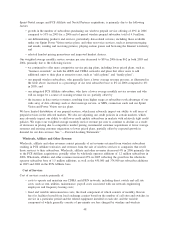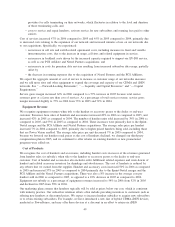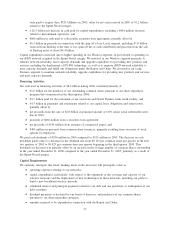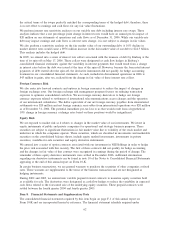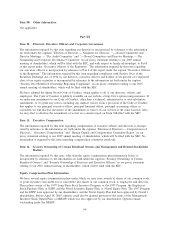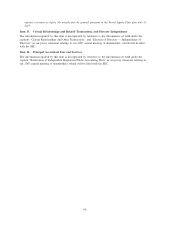Sprint - Nextel 2006 Annual Report Download - page 60
Download and view the complete annual report
Please find page 60 of the 2006 Sprint - Nextel annual report below. You can navigate through the pages in the report by either clicking on the pages listed below, or by using the keyword search tool below to find specific information within the annual report.kpotential costs of compliance with regulatory mandates; and
kother general corporate expenditures.
Liquidity
As of December 31, 2006, our cash and cash equivalents and marketable securities totaled $2.1 billion.
We have a $6.0 billion revolving credit facility, which represents our total committed financing capacity under
this facility. This credit facility, which expires in December 2010, provides for interest rates equal to the
London Interbank Offered Rate, or LIBOR, or Prime Rate plus a spread that varies depending on the parent
company’s credit ratings. There is no rating trigger that would allow the lenders involved to terminate this
facility in the event of a credit rating downgrade.
In April 2006, we commenced a commercial paper program, which reduced our borrowing costs by allowing
us to issue short-term debt at lower rates than those available under our $6.0 billion revolving credit facility.
The $2.0 billion program is backed by our revolving credit facility and reduces the amount we can borrow
under the facility to the extent of the commercial paper outstanding. As of December 31, 2006, we had
$514 million of commercial paper outstanding, net of discounts. Although our credit rating remains investment
grade, recent downgrades to our credit rating by major credit rating agencies have impacted, and may continue
to impact, our ability to place the paper with investors, as well as the duration and interest rates of commercial
paper issued since the ratings downgrade.
As of December 31, 2006, we had $2.6 billion in letters of credit, including a $2.5 billion letter of credit
required by the Report and Order, outstanding under our $6.0 billion revolving credit facility. These letters of
credit reduce the availability under the revolving credit facility by an equivalent amount. As a result of the
letters of credit and outstanding commercial paper, we had about $2.9 billion of borrowing capacity available
under our revolving credit facility. In addition, we had $16 million of general letters of credit outstanding.
As of December 31, 2006, we were in compliance with all debt covenants, including all financial ratio tests,
associated with our borrowings.
Our ability to fund our capital needs from outside sources is ultimately impacted by the overall capacity and
terms of the banking and securities markets. Given the volatility in these markets, we continue to monitor
them closely and to take steps to maintain financial flexibility and a reasonable capital cost structure.
As of December 31, 2006, we had working capital of $506 million compared to working capital of $5.0 billion
as of December 31, 2005. The decrease in working capital is primarily due to the utilization of cash to fund
our 2006 acquisitions, the impact of the spin-off of Embarq, debt payments and retirements, the purchase of
common shares and the retirement of our Seventh series redeemable preferred shares. In addition to cash, cash
equivalents and marketable securities, our working capital consists of accounts receivable, handset and
accessory inventory, prepaid expenses, deferred tax assets and other current assets, net of accounts payable,
accrued expenses and the current portion of long-term debt and capital lease obligations.
Future Contractual Obligations
The following table sets forth our best estimates as to the amounts and timing of contractual payments for our
most significant contractual obligations as of December 31, 2006. The information in the table reflects future
unconditional payments and is based upon, among other things, the terms of the relevant agreements,
appropriate classification of items under GAAP currently in effect and certain assumptions, such as future
58


